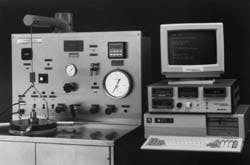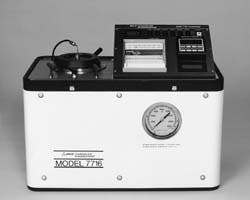Dan Webster, Jeff Moon
EG&G Chandler Engineering
Tulsa
Cement laboratories and service companies equipped with the latest generation of cement-testing instruments can measure rheological properties and compressive strength more accurately.
Oil and gas well cementing practices are covered by American Petroleum Institute Specification 10 (Spec 10) and Recommended Practices (RP 10B), which have become widely accepted worldwide. API Spec 10 is already translated into Chinese and is in wide use in China, and there is a recent move to translate Spec 10 into Russian for use there.1 2
The test regimens in API Spec 10 and RP 10B have provided the basis for successfully completing hundreds of thousands of wells and provide oil field personnel with a disciplined means for accurately predicting cement slurry performance under downhole conditions.
API Spec 10 testing procedures are also used by manufacturers of the specialized well cements and additives specified for well completion, so they can demonstrate to their customers that the supplied product meets specification. The use of API testing procedures over the years has created a large body of experience-based knowledge about slurry performance in specific geological formations in the well bore.
Many of the cement and testing labs, however, are using API Spec 10 instruments that were purchased during the "boom" years of the late 1970s and early 1980s before the advent of inexpensive personal computer systems. These instruments, if properly maintained, may still be in good mechanical shape; however, their controls and communication electronics may be outmoded.
These outdated electronics, coupled with inadequate equipment maintenance as a result of all the downsizing and turnover in the oil industry during the past 10 years, indicate that many labs have equipment that needs replacement or updating. The cost of new instruments is minimal, considering the substantial cost and low production because of a poor cement job.
Covette viscometer with electronic drive (Fig. 1)
Equipment available
Every lab must have a mixer to blend the well cement slurries prior to test. Labs that carefully adhere to API Spec 10 have constant-speed mixers to ensure a consistent mixing energy on every sample. This allows every slurry to be at the same point of hydration when testing begins.
Because cement slurries are very abrasive, the blades in the mixers tend to wear out quickly unless they are specially hardened. Worn mixer blades will yield cement slurry samples that produce misleading results.3
Most modern labs have a rotating rotor bob viscometer, known as a covette viscometer, to determine the rheological properties of the well cement (Fig. 1). The up-to-date models use a 12-speed, electronically driven motor to create the standard API Spec 10 shear rates. This design approach eliminates the maintenance associated with the gear train needed to create the standard shear rates.
Although not included in API Spec 10, a test of rheological properties at high pressure and temperature conditions can be useful in cement slurry design; these tests require a pressurized viscometer (Fig. 2).
Pressurized viscometer (Fig. 2)Additionally, a heated atmospheric (nonpressurized) consistometer is useful for cement sample testing and preparation.
Pressurized consistometer (Fig. 3)
A pressurized consistometer, or thickening time tester, is a mainstay instrument in most labs (Fig. 3). These instruments contain electronics which control the pressure and temperature inside an autoclave or pressure vessel. The slurry cup within the pressure vessel contains the cement sample, which undergoes a simulation of the flow temperature and pressure conditions expected downhole as the cement thickens. The time to reach 100 Bearden units of consistency, a measure of cement viscosity, is called the thickening time. This is the length of time a cement slurry remains pumpable under test conditions.
It is important to be able to control pressure and temperature accurately to simulate the particular well bore of interest. Older consistometers have less capable controls that require continuous operator intervention for proper operation. Newer consistometers come with fully automated pressure and temperature controllers that require no operator manipulation during a lengthy test, saving labor and providing more-accurate results.
Older consistometers used strip chart recorders to present the pressure, temperature, and cement consistency data over time, whereas the newer units use modern computer printers to present the results in more readable formats on a single sheet. These data can be stored using a data acquisition and presentation system with the output presented in color graphics. By storing the test information in a data base, test results from specific slurry designs can be compared over time.
Other mainstays of an API Spec 10 lab are the conventional pressurized curing chamber and newer ultrasonic curing and testing apparatus. These devices simulate downhole curing conditions after slurry placement. For the conventional instrument, a cement slurry is poured into molds which are placed in a curing chamber, which is an autoclave like the consistometer.
The cement is subjected to a ramp of temperature and pressure simulating well bore conditions, causing the cement to harden to the final compressive strength. The ramp profiles of the curing are maintained by electronic pressure and temperature controllers.
Most labs have some means of crushing cured cement cubes produced by the conventional test to determine compressive strength. Recently developed equipment can accurately control load rates electronically to the API Spec 10 parameters. For the newer ultrasonic testing instrument, the cement strength is determined by continuously measuring the transit time of an ultrasonic pulse through the cement sample as it cures or hardens with time.
Because the cement sample is not destroyed, this advanced instrument can predict the rate at which the cement is developing compressive strength in real time. These data are important because, by using data from the ultrasonic instrument, the drilling crew can trip the bit back in the hole to drill sooner than if they had to wait for the completion of the cycle from a conventional test.
All labs have some means to perform a fluid loss test, but a fluid loss tester with electronic controls and stirring mechanism is often easier and safer to use (Fig. 4).Stirred fluid loss tester (Fig. 4)
References
1. Contact with Mr. Huang Bo-Zong, chief research scientist of the cementing department at China National Petroleum Corp., Tanggu, Tianjin, China.
2. Contact with Dr. Zinoviy B. Entin, Ceimiscon, Moscow.
3. Testing conducted in 1985 by C.G. Shank, API work group chairman, indicates blade wear also greatly affects test results. The work group concluded that a 10% or greater loss in blade weight due to wear of a corrosion-resistant nontreated metal propeller blade results in a thickening time change of 10% or more.
The Authors
Webster
Moon
Dan Webster is president and general manager of EG&G Chandler Engineering in Tulsa. Webster has a BS from Clarkson College of Technology and an MBA from the University of Albany.
Jeff Moon is the manager of research and development and engineering for EG&G Chandler Engineering in Tulsa. Moon holds BSME and MSME degrees from Oklahoma State University and is a registered professional engineer in Oklahoma.
Copyright 1996 Oil & Gas Journal. All Rights Reserved.







